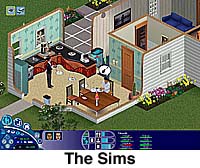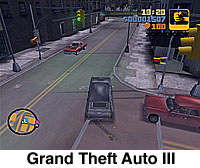













|
Thirty years after its origin, the elusive art of computer and video game design is beginning to take a distinct form. What was once a largely instinctive pursuit has begun to have its own rules and established techniques. As developers start to take their craft more seriously, there remains a delicate balance between the theory of game design and its actual practice. In Game Design: Theory & Practice Second Edition, the follow up to the successful original, game designer Richard Rouse III balances a discussion of the high-level goals of game design with how you can implement them in your current project using concrete examples from his own experience. Rouse discusses in depth key game design topics including game balancing, storytelling, non-linearity, player motivations, input/output, artificial intelligence, level design, multi-player gaming, and playtesting. This book delves into the entire breadth of interactive games, covering computer, console, online, and arcade titles, and spanning a diversity of gaming genres including strategy, adventure, simulation, action, role-playing, sports, and wargames. Game Design: Theory & Practice Second Edition leads you through the entire game development process, from brainstorming a game idea, establishing the focus, and determining the storytelling mode to getting the gameplay working, documenting the design, and playtesting. As each aspect of game design is discussed, relevant examples from successful and unsuccessful games are analyzed, and Rouse draws on his own experience in game development to add insight. Furthermore, readers will discover how to most effectively document their game ideas, including the use of the focus, pitch document, design document, game minute, story bible, script, and technical specification. It is important to note that Game Design: Theory & Practice will not teach you how to program games; there are plenty of books that do that already. Instead, by focusing on game design this book covers topics which will stay relevant to game development for years to come. Game Design: Theory & Practice is suited not only to game designers but to any game developer interested in making the gameplay on their project as fun as possible. Furthermore, the topics covered are general enough to apply to PC and Mac developers as well as console developers, with team sizes ranging from one to one hundred. Since its release in 2001, Game Design: Theory & Practice
has become one of the most respected books on game design in the industry
and is used as the primary text in countless college courses on game design
and development. The second edition of Game Design: Theory
& Practice fully updates the original version of the book, including
countless examples from games that have been released since the first edition
as well as delving into recent improvements in game development methodology.
New chapters include an in-depth discussion of multi-player game design,
a lengthy interview with revered game designer Doug Church, a detailed
analysis of the brilliant Grand Theft Auto III, and a new appendix
which includes the actual game design document used for Rouse's recent
action-horror game The Suffering. A new introduction is provided
by Game Developer Magazine game design columnist Noah Falstein.
Interviews Game Design: Theory & Practice Second Edition includes in-depth interviews with seven of the most respected game designers in the industry. These conversations go beyond the interviews typically found on web-sites or in magazines, as the designers discuss at length and in depth their careers and their personal techniques for designing games. For the second edition, most of the interviews from the original book have been expanded to incorporate the designers' thoughts on their newest works. Interview subjects include: Sid Meier, designer of Civilization, Pirates!, Railroad Tycoon, Gettysburg! and SimGolf "One of the rules of game design that I have learned over the years is that it's better to have one great game than two good games. And, unless you're careful, too many sub-games can lose the player. In other words, if you've got a good mini-game, then the player's going to get absorbed in that. And when they're done with that, they may well have lost the thread of what your story was or if any game is too engrossing it may disturb the flow of your story. Frankly, the mini-games in Pirates! were simple enough that you didn't lose track of where you were or what your objective was or what you were trying to do."Ed Logg, designer of Asteroids, Centipede, and Gauntlet "I do strive to give the players as much freedom to create as many strategies as possible. So in a sense, yes I guess I do encourage players to experiment and try different strategies. I do try to make sure that none of them work all the time or make the game too easy. But I want to leave the player with the impression that if he was only a little bit better he could pull it off."Steve Meretzky, designer of The Hitchhiker's Guide to the Galaxy, Planetfall, A Mind Forever Voyaging, and Zork Zero "I personally loved and still love the text-based interface, both from a player and a game writer point of view. But I don't mind either reading or typing, and some people dislike one or the other or both, and that tended to limit our audience, especially as non-reading, non-typing alternatives proliferated. But I find the parser-based input interface to be by far the most powerful and flexible, allowing the user to at least try anything he/she can think of, and allowing the game writer to develop all sorts of puzzles that wouldn't be possible with a point-and-click interface. So many point-and-click adventure games became a matter of simply clicking every object in sight in every possible combination, instead of thinking through the puzzle."
"What goes on between user and computer is primarily a matter of communication. I am deeply desirous of optimizing that communication. That means designing the computer display to most closely match the receptive powers of the human mind. And the two things that we are very good at are facial recognition and linguistic comprehension. Accordingly, those are the two things that computers should emphasize. Computer games have neither and that appalls me."Jordan Mechner, designer of Prince of Persia, Karateka, and The Last Express "Certainly story is becoming more appreciated as an element of games. But games are not about story. A movie is about the story, a game is about the gameplay. A good story can enrich a game, it can add to the pleasure, in much the same way that a good musical score can add to the enjoyment of a movie. But game designers can sometimes fall into the trap of developing a really complex story and thinking that somehow makes the game more complex or more interesting."Will Wright, designer of SimCity, The Sims, and The Sims Online "You can play games with toys. But you can also engage in more freeform play with toys. It doesn't have to be a goal directed activity. I think of toys as being more open-ended than games. We can use a ball to play a game such as basketball, or we can just toss the ball back and forth, or I can experiment with the ball, bouncing it off of different things. So, I would think of toys as a broader category. Also, toys can be combined. I can strap Barbie to my R.C. car and drive her around, thus making up a new activity by combining toys. Games tend to be isolated universes where there's a rule-set, and once you leave that universe the rule set is meaningless."Doug Church, designer of Ultima Underworld, System Shock, and Thief "Back then, one person could easily have the whole game in their head. All disciplines, all elements, all content. Maybe not easily, that's probably a little glib, but they can do it. And then five years later you probably couldn't have the whole game in your head but you probably could have a whole discipline in your head, or the story, or how it's structured. And nowadays, if you're a project leader your job is to get the eight or ten managers all seeing vaguely the same thing. Because what you have to do is get those eighty people to all act like they're seeing the same thing. That's hard, because the fact that humans communicate at all is sort of magical, as far as I can tell. And when you're talking about creative collaboration, creative collaboration's really, really hard. I really do think as a project leader these days your job is to Vulcan mind meld your team."
Game designers learn a lot about gameplay by playing other people's games, and analyzing what they do right and wrong. Game Design: Theory & Practice Second Edition includes detailed analyses of six classic games from six different genres that will help readers to understand the core mechanics of successful games and just why they are fun. The games analyzed are:
 
  Sample Design Documents: Atomic Sam and The Suffering The design document is the most important document in game design, yet it is surprising how many such documents are badly written. Many offer too little or too much detail, poor organization, or simply focus on the wrong aspects of the game in question. Game Design: Theory & Practice Second Edition includes design documents that follow similar formatting principles, but which are for extremely different games. The first is for a game called Atomic Sam, and stars a character of the same name who happens also to be featured on the cover of the book and in the illustrations which grace these web pages. Atomic Sam is a console game in the spirit of Super Mario 64 but with some unique twists both in terms of storytelling and gameplay. Some who have seen it like it so much they think it may be worth the price of the book alone. The second and longer document is for The Suffering, the action-horror
game designed by Richard Rouse III at Surreal Software and published in
2004 by Midway. The game blends an intense action experience with
a disturbing horror setting while incorporating a unique morality system
and innovative storytelling techniques. The design document is included
in the second edition exactly as it was used during the game's development.
Still not convinced you want to buy Game Design: Theory & Practice? Check out some sample chapters from the book, or read what the press has to say. |

Contents (C) 2001-2004 Richard Rouse III and Wordware
Publishing, unless otherwise noted.
Atomic Sam is TM and (C) 2001-2004 Richard Rouse III.
Atomic Sam character designed by Richard Rouse III and Steve Ogden.